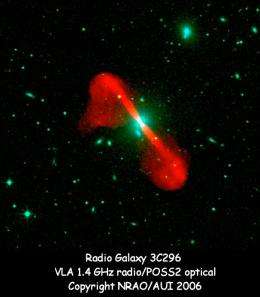A combined optical (green) and radio (red) image of an elliptical galaxy with jets of emission thought to be powered by a supermassive black hole at the galactic nucleus. SAO astronomers show that X-ray observations of such jets can also provide information on short time-scale activity. Credit: NRAO and AUI
(PhysOrg.com) -- The supermassive black holes that lie at the centers of galaxies can spawn tremendous bipolar jets of atomic particles.
These outflows, discovered at radio wavelengths, are thought to be produced by matter accreting onto a hot disk around the black hole.
There are many types of galaxies and radio jets, but in the most dramatic cases the hot particles extend across hundreds of thousands of light-years, well beyond the visible boundaries of the galaxy, and move at speeds close to the speed of light.
The physical processes that drive these jets and cause them to radiate are among the important outstanding problems of modern astrophysics.
One of the problems in deciphering how the jet mechanisms operate, and how they interact with the environment near the black hole nuclei, is the comparatively gradual way that radio emission responds to changes. As a result, differences that may occur along the jet (or at different times in the same location) appear blurred together when viewed at radio wavelengths.
X-rays are also emitted from these jets, but unlike radio emission they respond very quickly to changes. SAO astronomers and associates Diana Worrall, Mark Birkenshaw, Andreas Zezas and Pepi Fabbiano, together with three colleagues, used the Chandra X-Ray Observatory to measure the X-ray emission from jets in the galaxy 3C270.
By comparing the emission from both sides of the jets (and their environments) with the corresponding radio emission, they were able to reach several important conclusions. The first is that bright knots along the jet are driven by the effects of local magnetic fields. Another is that changes in the jets seem to have taken place during comparatively short timescales -- only tens or hundreds of thousands of years.
The exact causes, however, are not yet clear. The results suggest that X-ray observations might be the most powerful way to probe episodic activity around giant black holes.
Provided by Harvard-Smithsonian Center for Astrophysics























